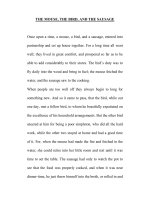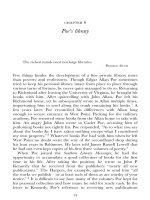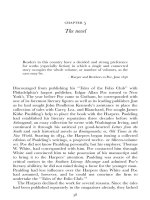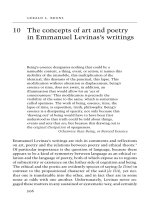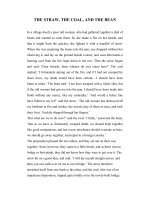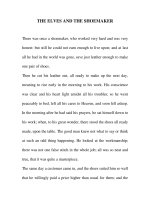Poe and the Printed Word - Poe''s library
Bạn đang xem bản rút gọn của tài liệu. Xem và tải ngay bản đầy đủ của tài liệu tại đây (72.86 KB, 13 trang )
chapter 6
Poe's library
The richest minds need not large libraries.
± Bronson Alcott
Few things hinder the development of a ®ne private library more
than poverty and restlessness. Though Edgar Allan Poe sometimes
tried to keep his personal library intact from place to place through
various turns of fortune, he never quite managed to do so. Returning
to Richmond after leaving the University of Virginia, he brought his
books with him. After quarrelling with John Allan, Poe left his
Richmond home, yet he subsequently wrote to Allan multiple times,
importuning him to send along the trunk containing his books.
1
A
few years later, Poe reconciled his differences with Allan long
enough to secure entrance to West Point. Packing for the military
academy,PoeremovedsomebooksfromtheAllanhometotakewith
him. An angry John Allan wrote to Cadet Poe, accusing him of
purloining books not rightly his. Poe responded, ``As to what you say
about the books &c I have taken nothing except what I considered
my own property.''
2
Whatever books Poe had with him when he left
West Point no doubt went the way of the secondhand shop during
his lean years in Baltimore. He later told James Russell Lowell that
he had not even kept copies of his ®rst three volumes of poetry.
3
When Poe joined the Southern Literary Messenger,hehadthe
opportunity to accumulate a good collection of books for the ®rst
time in his life. After taking the position, he wrote to John P.
Kennedy that he received from the publishers ``nearly all new
publications.'' The Harpers, for example, agreed to send him ``all
the works we publish ± or at least such of them as are worthy of your
notice.''
4
It is dif®cult to say how many of the volumes Poe kept for
his personal collection and how many he sold for ready cash. In the
letter to Kennedy, Poe's reference to receiving new publications
74
occurs immediately following a discussion of his salary at the
Messenger and therefore implies that the books represented a salary
supplement. The scant information which can be gleaned from Poe's
surviving correspondence suggests he did not hold onto the volumes
he received. Poe reviewed Frederick W. Thomas's ®rst novel, Clinton
Bradshaw, or, The Adventures of a Lawyer,fortheSouthern Literary
Messenger, yet some years later he did not have a copy on hand. He
and Thomas since had become good friends, and one morning Poe
wrote to tell him that he was ``going on a pilgrimage . . . to hunt up
a copy of `Clinton Bradshaw.' ''
5
Perhaps Thomas had personally
convinced Poe of the book's value. After his next novel, Howard
Pinckney, appeared, Thomas wondered whether he preferred Clinton
Bradshaw and told Poe, ``[O]ur ®rst book like our ®rst love ever has
the warmest place in our affections.''
6
Though Poe may have kept a
shelf of books in Richmond, the ®nancial pressures marriage
brought, exacerbated by a strong-willed mother-in-law who directly
equated books with currency, assure us that most new volumes did
not stay on Poe's shelf for long.
Poe may not have regretted the loss of these books too much, for
few would have enhanced his personal library, in terms of either
their outward appearance or the texts contained within. At the time
Poe began writing for the Messenger, the book, as a physical object,
was undergoing signi®cant change. Cotton cloth had been intro-
duced as a binding material only about ten years earlier. Before that,
publishers generally issued books in paper-covered boards. These
coverings were temporary ones designed to protect the stitched
gatherings until the purchaser had time to take the volume to the
bookbinder and have him prepare a ®ne leather binding. The book
owner, not the publisher, assumed the cost of bookbinding. The
introduction of muslin as a bookbinding material helped make
edition binding possible, but the invention of the casing process
more signi®cantly reduced the labor costs of bookbinding and
therefore convinced publishers to assume binding costs and begin
issuing bound editions. The casing process allowed book covers to be
assembled as separate units and then to be attached to the stitched
and gathered sheets cheaply and quickly. Cased books and muslin
bindings did not become commonplace until the mid-1830s, around
the time Poe began writing for the Southern Literary Messenger.
In New York, the Harpers began using cloth bindings in the mid-
1820s and were issuing cased books by 1831.
7
By 1836, the Harpers
Poe's library 75
had issued so many books bound in inexpensive muslin covers that
the ®rm practically became identi®ed with them. When the Harpers
issued the sixth edition of Charles Anthon's Sallust's Jugurthine War
and Conspiracy of Catiline with a good quality binding, Poe found it
noteworthy:
In respect to external appearance this is an exceedingly beautiful book,
whether we look to the quality of its paper, the clearness, uniform color,
and great accuracy of its typography, or the neatness and durability of its
covering. In this latter point especially the Harpers and other publishers
would do well, we think, to follow up the style of the present edition of
Sallust ± dropping at once and forever that ¯imsy and unsatisfactory
method of binding so universally prevalent just now, and whose sole
recommendation is its cheapness ± if indeed it be cheaper at all . . . No
man of taste ± certainly no lover of books and owner of a library ± would
hesitate at paying twice as much for a book worth preservation, and which
there is some possibility of preserving, as for one of these fragile ephemera
which it is now the fashion to do up in muslin.
8
Understanding Poe's pleasure with the Anthon binding and his
disgust with other contemporary cloth bindings requires knowledge
of one further technological innovation, the embossing process.
Embossing allowed manufacturers to give cotton cloth a variety of
textured patterns which greatly enhanced the aesthetics of the cloth-
bound book. The decorative embossing, which could make cloth
resemble the natural grain of morocco or the tooled patterns often
applied to calfskin, made it much easier for the book-buying public
to accept cloth bindings. Embossing, however, was not regularly
practiced in the American book industry until the late 1830s.
9
Even
after embossed cloth was introduced, some books continued to be
issued in unembossed muslin. Many editions were issued in a variety
of bindings. When the Harpers released the Narrative of Arthur Gordon
Pym in 1838, the work appeared with at least three different covers:
unembossed black muslin, black muslin embossed with a leafy
design, and blue cloth embossed with a textured pattern.
10
Poe was reviewing books for the Southern Literary Messenger at a
unique time in the history of American book production, after
muslin-cased books had been adopted widely by the industry yet
before embossed cloth had become standard. His reaction to muslin
was shared by many bibliophiles of the time. Compared to hand-
crafted, elegantly gilt and tooled leather bindings, the unembossed
muslin looked exactly like what it was, a sign that books were
76 Poe and the printed word
moving away from individual workmanship and toward mass pro-
duction. In terms of look and feel, muslin bindings sacri®ced
aesthetic pleasure for utility, convenience, and thrift. If Poe had to
give up muslin-bound books to make ends meet, it was not much of
a sacri®ce. Just as collectors nowadays refuse to shelf paperbacks
among their ®ne books, bibliophiles in Poe's day were reluctant to
allow muslin a place within their collections.
Lacking the natural texture and rich feel of leather, the muslin
bindings offended the sense of touch, but their bright colors offended
the discerning book-owner's sense of sight as well. Most leather
bindings were somber-hued, but muslin greatly increased the variety
of binding colors, and red, orange, and green books became
commonplace. Shelved books began looking like the bands of a color
spectrum. After its introduction, embossing would add texture and
shadow to the cloth bindings and therefore mellow the colors, but, as
a book reviewer in the mid 1830s, Poe often had to face books
covered in brightly colored, unembossed muslin. And he did not like
it. Green muslin particularly offended him.
In his critical notices for the Southern Literary Messenger,muslin
bindings became a touchstone for mediocrity. Though Poe was not
judging modern books by their covers, it did seem to him that such
poor coverings did little to mask the banalities they contained. He
called William L. Stone's Ups and Downs a ``public imposition'' in
part due to its ``customary muslin cover with a gilt stamp on the
back.''
11
Reviewing Lydia Maria Child's Philothea, a work he appre-
ciated, Poe remarked, ``Overwhelmed in a long-continued inun-
dation of second-hand airs and ignorance, done up in green muslin,
we turn to these pure and quiet pages with that species of gasping
satisfaction with which a drowning man clutches the shore.''
12
Poe
does not describe the binding of his copy of Philothea,butthebook
was issued in at least three different colors of cloth ± black, blue,
purple ± all fairly conservative and all decorated or embossed.
13
Poe provided further thoughts on bookbinding in his highly
favorable review of Augustus Baldwin Longstreet's Georgia Scenes.
``Altogether this very humorous, and very clever book forms an aera
in our reading,'' he wrote: ``It has reached us per mail, and without
a cover. We will have it bound forthwith, and give it a niche in our
library as a sure omen of better days for the literature of the
South.''
14
Georgia Scenes was issued in tan paper boards, an old-
fashioned binding for the muslin era. While suggesting that the work
Poe's library 77
represented a bright future for Southern literature, Poe's treatment
of the volume was reactionary, for he asserted that he would have
the bookbinder prepare a handsome binding worthy of his private
library. Good writing, Poe implied, deserved ®ne binding. There's no
telling whether he had the volume bound or even held onto it,
however. Even if he did not give Georgia Scenes a niche in his library, it
held a niche in his memory. Ten years later Poe recalled Longstreet
as the author ``over whose inimitable `Georgia Scenes' the whole
continent has been laughing till the tears rolled from its eyes.''
15
In some ways, Poe's physical description of the Georgia Scenes
volume was a ®ctional pose. It implied that he could afford to have
rebound whatever books he felt worthy, which he could not.
Furthermore, it suggested that he had a large personal library with
room enough for a special niche, which he did not. Poe did
recognize, however, that many of those who read the Southern Literary
Messenger could afford ®ne bindings and did have large personal
libraries. He once explained that the magazine's ``subscribers [were]
almost without exception the e
Â
lite, both as regards wealth and
intellectual culture, of the Southern aristocracy.''
16
Thomas White
sometimes ordered special books for his customers and occasionally
served as a go-between with the local bookbinders. Beverley Tucker,
for example, wrote to Poe, ``I will thank you to ask Mr. White to
procure me a copy of Burke's works as published in 1834, by
Dearborn of New York, in three volumes. I wish him to have them
lettered on the back near the bottom with the word Ardmore.''
17
A
young, poor, bookish man could only read these words with envy.
Imagine not only being able to afford a three-volume edition of The
Works of Edmund Burke,butalsobeingabletohaveabookbinder
custom letter its spine. Tucker's lettering reinforced the association
between a well-furnished home and shelves full of ®ne books.
Poe knew he could not afford a good library of his own, but he
saw no reason for his readers to know. For the Longstreet review, he
assumed the persona of a well-to-do gentleman who owned an
excellent library. Poe would retain the persona throughout his
editorial career. It gave him the authority to tell his audience what
books they should or should not have in their libraries. Reviewing
Eaton Stannard Barrett's The Heroine, or Adventures of Cherubina,for
instance, Poe told his readers, ``Cherubina is a book which should
be upon the shelves of every well-appointed library.''
18
At least
one reader of Poe's ``Literati of New York City'' read the periodical
78 Poe and the printed word


